10 apr 2015
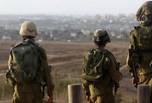
Israeli occupation forces (IOF) opened fire at dozens of Palestinian citizens in southern Gaza Strip afternoon Friday wounding a 17-year-old minor.
Medical sources told the PIC reporter that Ibrahim Abu Tir, 17, was hit with a bullet shot by the IOF in east of Abasan to the east of Khan Younis district in southern Gaza.
Dozens of young men head to the agricultural area to the east of Khan Younis each Friday on an excursion and to take photos. This is the fifth week in a row that IOF soldiers fire at the youths in flagrant violation of the calm agreement.
Medical sources told the PIC reporter that Ibrahim Abu Tir, 17, was hit with a bullet shot by the IOF in east of Abasan to the east of Khan Younis district in southern Gaza.
Dozens of young men head to the agricultural area to the east of Khan Younis each Friday on an excursion and to take photos. This is the fifth week in a row that IOF soldiers fire at the youths in flagrant violation of the calm agreement.
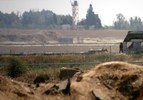
The Israeli occupation forces (IOF) opened their machinegun fire at Palestinian agricultural lands to the east of Khan Younis, south of the Gaza Strip.
Local sources told the Palestinian Information Center (PIC) that Israeli soldiers behind the border fence fired at nearby Palestinian agricultural lands. No casualties were reported.
The Israeli army intensified its violations in Gaza last March.
A human rights report said that four Israeli military incursions and 16 shooting incidents happened last month, during which five Gazans were wounded and four others were arrested.
The Israeli army has violated the Egyptian-brokered ceasefire agreement signed with the Palestinian resistance in Gaza several times since its war ended in last August.
Local sources told the Palestinian Information Center (PIC) that Israeli soldiers behind the border fence fired at nearby Palestinian agricultural lands. No casualties were reported.
The Israeli army intensified its violations in Gaza last March.
A human rights report said that four Israeli military incursions and 16 shooting incidents happened last month, during which five Gazans were wounded and four others were arrested.
The Israeli army has violated the Egyptian-brokered ceasefire agreement signed with the Palestinian resistance in Gaza several times since its war ended in last August.
9 apr 2015

A local resident inspects heavy damage at the historical al-Omari mosque in Jabalia in the northern Gaza Strip, on August 2, 2014
UN agency for Palestinian refugees UNRWA has only received funding to reconstruct 200 of the 9,061 houses destroyed in Gaza, said a report released on Thursday.
While some 60,000 Palestine refugee families have been able to complete the repair of their damaged homes with assistance provided through UNRWA, the majority of funding pledged by the international community for reconstruction following the most recent war in Gaza has not materialized, similar to promises made after previous wars.
According to Ma'an News Agency, UNWRA said that the Gaza Reconstruction Mechanism, a temporary agreement between the governments of Israel and Palestine concluded in September 2014, allows the entry of building materials for repair, but the process for rebuilding totally destroyed homes remains yet to be agreed upon.
While import of construction material is banned by Israel but possible for UN-led projects following a lengthy approval procedure since 2010, the UNRWA shelter self-help program is completely reliant on the GRM, limiting the range of reconstruction possible.
Limitation on shipments of building materials also continue, with Israeli authorities adding restrictions on wood shipments to the Gaza Strip earlier this week.
A COGAT official told Ma'an that the decision came as a response to wood having allegedly been used to reinforce the "terror infrastructure" within the Gaza Strip.
In response, COGAT Coordinator Maj.-Gen. Yoav Mordechai "decided in consultation with security authorities that the transfer of certain wooden planks into the Gaza Strip will be allowed with a specific permit to be issued by the Coordination and Liaison Administration to the Gaza Strip."
At current rates it would take up to 100 years to rebuild homes, schools and other damaged infrastructure, OXFAM reported in February.
The process to repair Gaza from three consecutive wars is further complicated by difficulties that have arrived alongside Palestinian factions efforts to create a unity government.
Hamas accused the Palestinian Authority in February of interfering with money earmarked for the reconstruction of the Gaza Strip.
In late March, however, Prime Minister Rami Hamdallah stressed the necessity of national reconciliation in regards to Gaza during his second visit to the coastal enclave since the formation of a national unity government between Fatah and Hamas in June, saying that the Palestinian government "will not accept separating or isolating Gaza."
A recent poll by the Palestinian Center for Policy and Survey Research reported that 44% of Palestinians want the reconciliation government to be in charge of the reconstruction of the Gaza Strip and 30% want it placed in the hands of Hamas.
The United Nations and other agencies have warned that failure to rehabilitate Gaza will lead to further conflict in the near future, and have urged Israel to lift its eight-year blockade of the enclave.
UN agency for Palestinian refugees UNRWA has only received funding to reconstruct 200 of the 9,061 houses destroyed in Gaza, said a report released on Thursday.
While some 60,000 Palestine refugee families have been able to complete the repair of their damaged homes with assistance provided through UNRWA, the majority of funding pledged by the international community for reconstruction following the most recent war in Gaza has not materialized, similar to promises made after previous wars.
According to Ma'an News Agency, UNWRA said that the Gaza Reconstruction Mechanism, a temporary agreement between the governments of Israel and Palestine concluded in September 2014, allows the entry of building materials for repair, but the process for rebuilding totally destroyed homes remains yet to be agreed upon.
While import of construction material is banned by Israel but possible for UN-led projects following a lengthy approval procedure since 2010, the UNRWA shelter self-help program is completely reliant on the GRM, limiting the range of reconstruction possible.
Limitation on shipments of building materials also continue, with Israeli authorities adding restrictions on wood shipments to the Gaza Strip earlier this week.
A COGAT official told Ma'an that the decision came as a response to wood having allegedly been used to reinforce the "terror infrastructure" within the Gaza Strip.
In response, COGAT Coordinator Maj.-Gen. Yoav Mordechai "decided in consultation with security authorities that the transfer of certain wooden planks into the Gaza Strip will be allowed with a specific permit to be issued by the Coordination and Liaison Administration to the Gaza Strip."
At current rates it would take up to 100 years to rebuild homes, schools and other damaged infrastructure, OXFAM reported in February.
The process to repair Gaza from three consecutive wars is further complicated by difficulties that have arrived alongside Palestinian factions efforts to create a unity government.
Hamas accused the Palestinian Authority in February of interfering with money earmarked for the reconstruction of the Gaza Strip.
In late March, however, Prime Minister Rami Hamdallah stressed the necessity of national reconciliation in regards to Gaza during his second visit to the coastal enclave since the formation of a national unity government between Fatah and Hamas in June, saying that the Palestinian government "will not accept separating or isolating Gaza."
A recent poll by the Palestinian Center for Policy and Survey Research reported that 44% of Palestinians want the reconciliation government to be in charge of the reconstruction of the Gaza Strip and 30% want it placed in the hands of Hamas.
The United Nations and other agencies have warned that failure to rehabilitate Gaza will lead to further conflict in the near future, and have urged Israel to lift its eight-year blockade of the enclave.
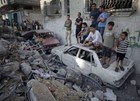
Two Gazan children on Wednesday night suffered shrapnel injuries when an explosive object they were playing with detonated at them.
Local sources said that five-year-old Musab Sawarka and six-year-old Hiba Abu Mashi were wounded in the blast of un-exploded ordnance they found in al-Birka area, south of Deir al-Balah.
Security sources told the Palestinian Information Center (PIC) that the un-exploded ordnance was believed to be part of an Israeli missile that had been used by the Israeli army during the last war on Gaza.
The sources added that the two kids were rushed to Aqsa Martyrs hospital in Deir al-Balah and then to al-Shifa hospital, describing their wounds as moderate.
The Israeli army had left a large amount of un-exploded ordnance during and after its last war on Gaza, which caused dozens of citizens, including children, to suffer different injuries.
Local sources said that five-year-old Musab Sawarka and six-year-old Hiba Abu Mashi were wounded in the blast of un-exploded ordnance they found in al-Birka area, south of Deir al-Balah.
Security sources told the Palestinian Information Center (PIC) that the un-exploded ordnance was believed to be part of an Israeli missile that had been used by the Israeli army during the last war on Gaza.
The sources added that the two kids were rushed to Aqsa Martyrs hospital in Deir al-Balah and then to al-Shifa hospital, describing their wounds as moderate.
The Israeli army had left a large amount of un-exploded ordnance during and after its last war on Gaza, which caused dozens of citizens, including children, to suffer different injuries.

The United Nations revealed Wednesday that the Israeli summer aggression on Gaza has left 7,000 explosive remnants.
During a ceremony marking the International Day for Mine Awareness and Assistance in Mine Action, United Nations Humanitarian Coordinator (OCHA) for the occupied Palestinian territory (OPT) James Rawley called for removing all the explosive remnants of Israeli aggression on Gaza.
"We want Gaza to be a safe place", Rawley said, pointing out that Israel’s recent war on Gaza left 7,000 explosive remnants.
For his part, director of UNRWA operations in Gaza Robert Turner said that his organization launched in coordination with UNMAS institution a project to remove all the suspicious objects from the Gaza Strip.
There are still a high number of suspicious objects left in Gaza Strip. We face a big problem in dealing with them, Turner underlined.
He stressed the urgent need to remove the landmines and un-exploded ordinance left behind after the summer war as they pose a real threat for the people of Gaza.
During the ceremony, the UN Goodwill Ambassador Mohammed Assaf pointed to the difficult humanitarian situation in the Strip due to the continued Israeli siege over the past consecutive eight years.
Assaf stressed the importance of lifting the siege on the people of Gaza who “deserve to live in dignity like all the peoples of the world.”
On 8 December 2005, the General Assembly of the United Nations declared that the 4th of April of each year shall be observed as the International Day for Mine Awareness and Assistance in Mine Action.
Many Palestinian victims were recently reported due to the explosion of landmines and other explosive remnants of Israeli war on Gaza.
In early July 2014, Israel carried out a brutal offensive on the besieged strip of Gaza that lasted for 51 days and resulted in 2311 martyrs and thousands of injured.
During a ceremony marking the International Day for Mine Awareness and Assistance in Mine Action, United Nations Humanitarian Coordinator (OCHA) for the occupied Palestinian territory (OPT) James Rawley called for removing all the explosive remnants of Israeli aggression on Gaza.
"We want Gaza to be a safe place", Rawley said, pointing out that Israel’s recent war on Gaza left 7,000 explosive remnants.
For his part, director of UNRWA operations in Gaza Robert Turner said that his organization launched in coordination with UNMAS institution a project to remove all the suspicious objects from the Gaza Strip.
There are still a high number of suspicious objects left in Gaza Strip. We face a big problem in dealing with them, Turner underlined.
He stressed the urgent need to remove the landmines and un-exploded ordinance left behind after the summer war as they pose a real threat for the people of Gaza.
During the ceremony, the UN Goodwill Ambassador Mohammed Assaf pointed to the difficult humanitarian situation in the Strip due to the continued Israeli siege over the past consecutive eight years.
Assaf stressed the importance of lifting the siege on the people of Gaza who “deserve to live in dignity like all the peoples of the world.”
On 8 December 2005, the General Assembly of the United Nations declared that the 4th of April of each year shall be observed as the International Day for Mine Awareness and Assistance in Mine Action.
Many Palestinian victims were recently reported due to the explosion of landmines and other explosive remnants of Israeli war on Gaza.
In early July 2014, Israel carried out a brutal offensive on the besieged strip of Gaza that lasted for 51 days and resulted in 2311 martyrs and thousands of injured.

Loved ones of Golani fighters killed in battle in Saja'iyya respond to Ynet publication of testimonies from night of attack.
Families of the seven Golani Brigade soldiers killed in the Operation Protective Edge battle on the outskirts of Saja'iyaa are now demanding answers to unresolved questions relating to the incident.
The families' demands come 24 hours after the Ynet publication of testimonies from junior commanders in the field on the night of July 19.
"We feel uneasy about the things that have emerged from the testimonies that were published," one bereaved family member said in the wake of the publication.
"We expect the army to provide us with answers to the claims voiced by the fighters. When our sons' commanders say they were given the cold shoulder by the army, we need to hear what they have to say."
The same family member also called on the fighters who survived the incident to speak to the families and tell them all they know.
"Don't be afraid, and don't be embarrassed," she said. "We simply want to know what really happened there. We're not angry with you."
She added that she and her family had learned new details about the incident from testimonies of the fighters. "I didn't know, for example, about the navigation error," she said. These are tough days for us."
According to the testimonies published on Tuesday, the two armored personnel carriers caught up in the battle on the outskirts of Saja'iyya were involved two days earlier in an accident, which may have been the reason why the one broke down and became an easy target for Hamas. The two APCs were checked after the accident and declared fit for operational duties.
The fighters in the field also said that the two APCs had taken the wrong route due to a navigational error on the part of the tanks that were leading them. This error, they said, also caused a long delay in the arrival of reinforcements, which were unable to pinpoint their location.
"The testimonies of the fighters involved in the incident are very important," said Herzl Shaul, the father of Staff Sergeant Oron Shaul, who was killed in the APC disaster and whose remains were snatched by Hamas. "It's important for all the people of Israel to know what happened so as to prevent a similar disaster in the future."
Ida Ta'aseh, the mother of Shahar Ta'aseh, who was also killed in the incident, is still waiting for more information.
"At this stage, we are harboring a lot of anger, as are other bereaved families; but we still don’t know everything," she said.
Related articles:
Families of the seven Golani Brigade soldiers killed in the Operation Protective Edge battle on the outskirts of Saja'iyaa are now demanding answers to unresolved questions relating to the incident.
The families' demands come 24 hours after the Ynet publication of testimonies from junior commanders in the field on the night of July 19.
"We feel uneasy about the things that have emerged from the testimonies that were published," one bereaved family member said in the wake of the publication.
"We expect the army to provide us with answers to the claims voiced by the fighters. When our sons' commanders say they were given the cold shoulder by the army, we need to hear what they have to say."
The same family member also called on the fighters who survived the incident to speak to the families and tell them all they know.
"Don't be afraid, and don't be embarrassed," she said. "We simply want to know what really happened there. We're not angry with you."
She added that she and her family had learned new details about the incident from testimonies of the fighters. "I didn't know, for example, about the navigation error," she said. These are tough days for us."
According to the testimonies published on Tuesday, the two armored personnel carriers caught up in the battle on the outskirts of Saja'iyya were involved two days earlier in an accident, which may have been the reason why the one broke down and became an easy target for Hamas. The two APCs were checked after the accident and declared fit for operational duties.
The fighters in the field also said that the two APCs had taken the wrong route due to a navigational error on the part of the tanks that were leading them. This error, they said, also caused a long delay in the arrival of reinforcements, which were unable to pinpoint their location.
"The testimonies of the fighters involved in the incident are very important," said Herzl Shaul, the father of Staff Sergeant Oron Shaul, who was killed in the APC disaster and whose remains were snatched by Hamas. "It's important for all the people of Israel to know what happened so as to prevent a similar disaster in the future."
Ida Ta'aseh, the mother of Shahar Ta'aseh, who was also killed in the incident, is still waiting for more information.
"At this stage, we are harboring a lot of anger, as are other bereaved families; but we still don’t know everything," she said.
Related articles:
- 13 Golani soldiers killed in Gaza
- 'Gaza conflict was victory for Israel, defeat for Hamas'
- The darkest night of the Gaza conflict
8 apr 2015
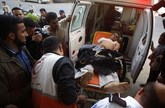
The Israeli Occupation Forces (IOF) on Wednesday evening shot and injured a Palestinian man in northern Gaza Strip.
A 25-year-old young man was slightly injured after being shot with a rubber bullet in his foot by Israeli soldiers stationed at the northern borders of Gaza, spokesperson for health ministry said.
IOF soldiers routinely shoot at Palestinian farmers in their agricultural lands near the border fence.
A 25-year-old young man was slightly injured after being shot with a rubber bullet in his foot by Israeli soldiers stationed at the northern borders of Gaza, spokesperson for health ministry said.
IOF soldiers routinely shoot at Palestinian farmers in their agricultural lands near the border fence.

Two Palestinian fishermen paddle their small boat off the beach of Gaza City while casting their nets on Aug. 10, 2014.
Israeli forces, Wednesday, shot and injured a Palestinian man with a rubber-coated steel bullet as he fished off the coast of the northern Gaza Strip.
Local sources said that fisherman Khalid Zayid was shot while he was at sea, off the coast of the town of Beit Lahiya.
An Israeli military spokeswoman did not return a request for comment.
Israeli authorities maintained a limit of three miles on all activities of fishermen in the Gaza Strip until August, when Hamas negotiated a six-mile limit as part of the ceasefire that concluded Israel's two-month summer assault that left 2,200 dead. According to the terms of the ceasefire, the fishing zone was supposed to expand incrementally, over the months which followed.
But Israeli authorities have frequently shot at Palestinian fishermen inside the limit, and three have been killed since then.
Twenty-nine attacks by Israeli forces on Palestinian fisherman have have been reported since Sept. 1 by Gaza-based watchdog al-Mezan Center for Human Rights, however due to the normalcy of such incidents, attacks often go unreported.
The center also said that 42 fisherman had been detained and 12 fishing boats confiscated in the same period.
There are approximately 4,000 fishermen in Gaza.
According to a 2011 report by the International Committee of the Red Cross, 90 percent are poor, an increase of 40 percent from 2008 and a direct result of Israeli limits on the fishing industry.
The Gaza Strip has been under a blockade imposed by the State of Israel since 2006 which has devastated the economy through near-complete limits on imports and exports.
The blockade has massively increased Palestinian dependence on international food aid, and the fishing industry is one of the few ways Gazans can produce their own food sources.
Israeli forces, Wednesday, shot and injured a Palestinian man with a rubber-coated steel bullet as he fished off the coast of the northern Gaza Strip.
Local sources said that fisherman Khalid Zayid was shot while he was at sea, off the coast of the town of Beit Lahiya.
An Israeli military spokeswoman did not return a request for comment.
Israeli authorities maintained a limit of three miles on all activities of fishermen in the Gaza Strip until August, when Hamas negotiated a six-mile limit as part of the ceasefire that concluded Israel's two-month summer assault that left 2,200 dead. According to the terms of the ceasefire, the fishing zone was supposed to expand incrementally, over the months which followed.
But Israeli authorities have frequently shot at Palestinian fishermen inside the limit, and three have been killed since then.
Twenty-nine attacks by Israeli forces on Palestinian fisherman have have been reported since Sept. 1 by Gaza-based watchdog al-Mezan Center for Human Rights, however due to the normalcy of such incidents, attacks often go unreported.
The center also said that 42 fisherman had been detained and 12 fishing boats confiscated in the same period.
There are approximately 4,000 fishermen in Gaza.
According to a 2011 report by the International Committee of the Red Cross, 90 percent are poor, an increase of 40 percent from 2008 and a direct result of Israeli limits on the fishing industry.
The Gaza Strip has been under a blockade imposed by the State of Israel since 2006 which has devastated the economy through near-complete limits on imports and exports.
The blockade has massively increased Palestinian dependence on international food aid, and the fishing industry is one of the few ways Gazans can produce their own food sources.
7 apr 2015
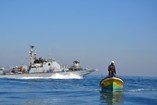
The Israeli navy opened fire at Gazan fishermen 39 times during the past three months, which led to the killing of one of them and the injury of six others, a recent report released by the Palestinian Center for Human Rights said.
The center, which documented Israel's violations against Palestinian fishermen since the beginning of this year, reported four incidents of piracy, during which the Israeli naval forces kidnapped 14 fishermen, confiscated four fishing boats and two nets, and destroyed fishing gear five times.
The center affirmed that the Israeli navy did not abide by the Egyptian-brokered truce agreement that had been signed on August 26, 2014 with the Palestinian resistance in Gaza, under which the Gazan fishermen were allowed to work in Gaza waters within a distance of six nautical miles.
The center, which documented Israel's violations against Palestinian fishermen since the beginning of this year, reported four incidents of piracy, during which the Israeli naval forces kidnapped 14 fishermen, confiscated four fishing boats and two nets, and destroyed fishing gear five times.
The center affirmed that the Israeli navy did not abide by the Egyptian-brokered truce agreement that had been signed on August 26, 2014 with the Palestinian resistance in Gaza, under which the Gazan fishermen were allowed to work in Gaza waters within a distance of six nautical miles.
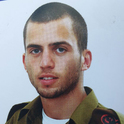
Oron Shaul. His body was seized by Hamas
Testimonies from commanders in the field paint a chilling picture of what happened in Saja'iyya on the night of July 19, when 7 IDF soldiers were killed.
It was one of the hardest nights of Operation Protective Edge – the night between July 19 and 20, the start of the assault on the Hamas stronghold in Saja'iyya, a neighborhood in eastern Gaza City, and the incident that exacted the summer's highest price, when an anti-tank missile slammed into an Israel Defense Forces' armored personnel carrier (APC) and killed seven Golani Brigade soldiers, including Staff Sergeant Oron Shaul, whose remains were snatched by Hamas fighters.
Now, testimonies and statements from junior commanders in the field at the time are pieced together and paint a chilling picture of what happened that terrible night on the outskirts of Saja'iyya.
The fighters said their initial orders were to take control of two high-rise buildings Saja'iyya, but that their objective was amended some two hours before the start of the battle in light of new intelligence reports. And that's how, they said, four Armored Corps tanks, followed by two APCs carrying fighters from Battalion 13 of the Golani Brigade, ended up moving deep into the Gaza Strip.
At some point, the fighters continued, communication between the four tanks was lost and the two tanks at the back lost their way, thus leading the two APCs behind them along the wrong route and into a lemon orchard. Suddenly, the first APC ground to a halt, but the two tanks drove on, leaving the Golani fighters alone.
'My finger on the pin'
First Lieutenant Ohad Rozwold, the commander of the APC that broke down, and his radio operator got out of the vehicle, went over to speak to the commander of the second APC, and then headed back to their own vehicle again.
"I was about a meter and half or two meters from the APC when it exploded," Rozwold later recalled. "They fired an RPG that hit the APC's engine and caused an explosion. I was left lying there without a weapon, with my legs paralyzed and unable to move. I removed a grenade from my battle vest and my finger was on the pin."
G. witnessed the explosion from the second APC. "Suddenly I saw something that looked like a comet flying and hitting the APC," he recounted.
"No one knows exactly where the soldiers were. Ohad said he saw two soldiers outside the APC by then, but the IDF still hasn't been able to investigate and tell the families exactly where the soldiers were killed."
The IDF believes that all the soldiers killed in the incident were in the APC itself when the missile struck.
"Immediately after the missile hit, we came under heavy Kalashnikov fire," G. said. "I could see Ohad's APC on fire and I screamed into the radio: 'I have an APC on fire; the entire crew is dead'. I simply couldn't believe my eyes."
Sergeant Aharon Amar, 23, also witnessed the explosion from the second APC. "It was like a terrible movie going through my head, but I realized we have to press on and get the rest of the guys moving," Amar said. "It's not easy watching your friends burn, but you have to keep the operation going."
G. and the other soldiers from the second APC then began making their way towards the burning vehicle. "Ohad's radio operator saw us approaching and thought it was a terror cell, and his weapon was already aimed at me," G. recalled.
"He asked Ohad for the okay to open fire, but Ohad asked him to describe my silhouette – and at the last minute, just before the radio operator pulled the trigger, he told him it was me and not to shoot. He saved my life; another second and they would have killed me."
'No bodies intact'
At the same time, the troops were coming under fire from all directions.
"I said on the radio that I need the tanks as quickly as possible because I can't move towards the burning APC without cover fire," G. said. "The APC was just 20 meters away from me but everything was on fire and the area was all lit up. I was afraid that if we approached, the force will sustain more fatalities."
G. tried to direct the tank company commander to the location, but the commander was unable to find them due to the navigation error at the start of the operation. According to the fighters in the field, it took the tanks more than 40 minutes to arrive on the scene, despite the fact that they were just 400 meters away.
"I try to direct the tank company commander to me, but it took him time to get here because he didn't take the same route we did," G. noted.
"There's a doctor in the company commander's tank, and Ohad was starting to lose consciousness by then. He got hit by bullets in the legs, broke two vertebrae in his back and there was a piece of shrapnel in his arm. The medic had stopped the bleeding. But the company commander and the doctor weren't showing up."
When the tanks arrived, G. and the other fighters tried to dowse the flames with fire extinguishers.
"We soon realized what was happening there," G. said. "There were no whole bodies, everything was on fire, and our efforts to put out the fire were useless. Three fighters who were with me were simply in shock, couldn't move. Shell shock."
Some of the fighters claim that the IDF's findings, which were presented to the bereaved families in recent days, don't paint a complete picture of what went down that night.
"We were given the cold shoulder by the battalion and brigade commanders," they say in their testimonies. "Quite a few things went wrong in that battle, and it can't all be dropped on us, the junior fighters."
Testimonies from commanders in the field paint a chilling picture of what happened in Saja'iyya on the night of July 19, when 7 IDF soldiers were killed.
It was one of the hardest nights of Operation Protective Edge – the night between July 19 and 20, the start of the assault on the Hamas stronghold in Saja'iyya, a neighborhood in eastern Gaza City, and the incident that exacted the summer's highest price, when an anti-tank missile slammed into an Israel Defense Forces' armored personnel carrier (APC) and killed seven Golani Brigade soldiers, including Staff Sergeant Oron Shaul, whose remains were snatched by Hamas fighters.
Now, testimonies and statements from junior commanders in the field at the time are pieced together and paint a chilling picture of what happened that terrible night on the outskirts of Saja'iyya.
The fighters said their initial orders were to take control of two high-rise buildings Saja'iyya, but that their objective was amended some two hours before the start of the battle in light of new intelligence reports. And that's how, they said, four Armored Corps tanks, followed by two APCs carrying fighters from Battalion 13 of the Golani Brigade, ended up moving deep into the Gaza Strip.
At some point, the fighters continued, communication between the four tanks was lost and the two tanks at the back lost their way, thus leading the two APCs behind them along the wrong route and into a lemon orchard. Suddenly, the first APC ground to a halt, but the two tanks drove on, leaving the Golani fighters alone.
'My finger on the pin'
First Lieutenant Ohad Rozwold, the commander of the APC that broke down, and his radio operator got out of the vehicle, went over to speak to the commander of the second APC, and then headed back to their own vehicle again.
"I was about a meter and half or two meters from the APC when it exploded," Rozwold later recalled. "They fired an RPG that hit the APC's engine and caused an explosion. I was left lying there without a weapon, with my legs paralyzed and unable to move. I removed a grenade from my battle vest and my finger was on the pin."
G. witnessed the explosion from the second APC. "Suddenly I saw something that looked like a comet flying and hitting the APC," he recounted.
"No one knows exactly where the soldiers were. Ohad said he saw two soldiers outside the APC by then, but the IDF still hasn't been able to investigate and tell the families exactly where the soldiers were killed."
The IDF believes that all the soldiers killed in the incident were in the APC itself when the missile struck.
"Immediately after the missile hit, we came under heavy Kalashnikov fire," G. said. "I could see Ohad's APC on fire and I screamed into the radio: 'I have an APC on fire; the entire crew is dead'. I simply couldn't believe my eyes."
Sergeant Aharon Amar, 23, also witnessed the explosion from the second APC. "It was like a terrible movie going through my head, but I realized we have to press on and get the rest of the guys moving," Amar said. "It's not easy watching your friends burn, but you have to keep the operation going."
G. and the other soldiers from the second APC then began making their way towards the burning vehicle. "Ohad's radio operator saw us approaching and thought it was a terror cell, and his weapon was already aimed at me," G. recalled.
"He asked Ohad for the okay to open fire, but Ohad asked him to describe my silhouette – and at the last minute, just before the radio operator pulled the trigger, he told him it was me and not to shoot. He saved my life; another second and they would have killed me."
'No bodies intact'
At the same time, the troops were coming under fire from all directions.
"I said on the radio that I need the tanks as quickly as possible because I can't move towards the burning APC without cover fire," G. said. "The APC was just 20 meters away from me but everything was on fire and the area was all lit up. I was afraid that if we approached, the force will sustain more fatalities."
G. tried to direct the tank company commander to the location, but the commander was unable to find them due to the navigation error at the start of the operation. According to the fighters in the field, it took the tanks more than 40 minutes to arrive on the scene, despite the fact that they were just 400 meters away.
"I try to direct the tank company commander to me, but it took him time to get here because he didn't take the same route we did," G. noted.
"There's a doctor in the company commander's tank, and Ohad was starting to lose consciousness by then. He got hit by bullets in the legs, broke two vertebrae in his back and there was a piece of shrapnel in his arm. The medic had stopped the bleeding. But the company commander and the doctor weren't showing up."
When the tanks arrived, G. and the other fighters tried to dowse the flames with fire extinguishers.
"We soon realized what was happening there," G. said. "There were no whole bodies, everything was on fire, and our efforts to put out the fire were useless. Three fighters who were with me were simply in shock, couldn't move. Shell shock."
Some of the fighters claim that the IDF's findings, which were presented to the bereaved families in recent days, don't paint a complete picture of what went down that night.
"We were given the cold shoulder by the battalion and brigade commanders," they say in their testimonies. "Quite a few things went wrong in that battle, and it can't all be dropped on us, the junior fighters."
6 apr 2015
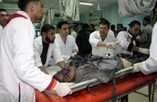
Two citizens, on Sunday, were critically injured due to a leftover missile explosion East of Al-Shuja'eyya neighbourhood in Gaza. The same neighborhood was flattened by Israel last summer.
According to the PNN, the two injured were on farmland near Al-Mintar crossing, east of the city, when the missile exploded.
They were moved to Al-Shifaa medical center. Medics reported one as severely critical, and the other as critical.
In the last war on Gaza, Israeli Military dropped numerous missiles and related devices which hadn't exploded at the time, but have caused 5 deaths and 7 injuries since.
"Operation Protective Edge" saw the deaths of about 2,200, injured 11,000 and displaced 100,000 Gazans. Palestinians are now the largest refugee group in the world, according to UN statistics.
According to the PNN, the two injured were on farmland near Al-Mintar crossing, east of the city, when the missile exploded.
They were moved to Al-Shifaa medical center. Medics reported one as severely critical, and the other as critical.
In the last war on Gaza, Israeli Military dropped numerous missiles and related devices which hadn't exploded at the time, but have caused 5 deaths and 7 injuries since.
"Operation Protective Edge" saw the deaths of about 2,200, injured 11,000 and displaced 100,000 Gazans. Palestinians are now the largest refugee group in the world, according to UN statistics.

Member of Hamas's political bureau Ziyad al-Zaza said that his Movement talks with the Israeli occupation only through its resistance weapon and its truce with it was never real.
During a political symposium held on Sunday by the information office of Hamas in Gaza, Zaza scoffed at what Palestinian president Mahmoud Abbas recently claimed that Hamas wanted to establish a state in the Sinai or with temporary borders, describing his remarks in this regards as a form of "psychological projection."
In another context, the Hamas official talked about the Swish document of proposals to solve the problem of unpaid civil servants in Gaza, affirming that his Movement agreed on the general principles and main points of the document.
He said that the most prominent points of the document which the Movement had been opposed to were about the early retirement and the security screening of the civil servants, affirming that the employees' right to job security cannot be conceded.
The official noted that his Movement is awaiting a response from the unity government on the Swiss document.
During a political symposium held on Sunday by the information office of Hamas in Gaza, Zaza scoffed at what Palestinian president Mahmoud Abbas recently claimed that Hamas wanted to establish a state in the Sinai or with temporary borders, describing his remarks in this regards as a form of "psychological projection."
In another context, the Hamas official talked about the Swish document of proposals to solve the problem of unpaid civil servants in Gaza, affirming that his Movement agreed on the general principles and main points of the document.
He said that the most prominent points of the document which the Movement had been opposed to were about the early retirement and the security screening of the civil servants, affirming that the employees' right to job security cannot be conceded.
The official noted that his Movement is awaiting a response from the unity government on the Swiss document.
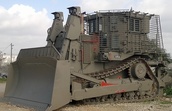
Armored Israeli Military Bulldozer
Navy Ships Open Fire On Fishing Boats Near Rafah
A number of armored Israeli military vehicles carried out, on Monday morning, a limited invasion into Palestinian lands, southeast of Khan Younis, in the southern part of the Gaza Strip.
Media sources in Khan Younis said the soldiers first opened fire from military towers in the Kissufim base, across the border; no injuries were reported.
Following the shooting, at least four Israeli army bulldozers and a few vehicles, stationed in the Sofa army base, advanced nearly 200 meters into Palestinian lands, and conducted military searches in the area.
In related news, Israeli navy ships opened fire on a number of Palestinian fishing boats in Gaza territorial waters, close to the shore, near Rafah in the southern part of the coastal region.
The attack forced the fishers back to shore; the fishers managed to escape the attack physically unharmed.
The latest assaults are part of repeated Israeli violations against the Palestinians, their homes and lands, in different parts of the impoverished, war-torn, besieged coastal region.
Navy Ships Open Fire On Fishing Boats Near Rafah
A number of armored Israeli military vehicles carried out, on Monday morning, a limited invasion into Palestinian lands, southeast of Khan Younis, in the southern part of the Gaza Strip.
Media sources in Khan Younis said the soldiers first opened fire from military towers in the Kissufim base, across the border; no injuries were reported.
Following the shooting, at least four Israeli army bulldozers and a few vehicles, stationed in the Sofa army base, advanced nearly 200 meters into Palestinian lands, and conducted military searches in the area.
In related news, Israeli navy ships opened fire on a number of Palestinian fishing boats in Gaza territorial waters, close to the shore, near Rafah in the southern part of the coastal region.
The attack forced the fishers back to shore; the fishers managed to escape the attack physically unharmed.
The latest assaults are part of repeated Israeli violations against the Palestinians, their homes and lands, in different parts of the impoverished, war-torn, besieged coastal region.
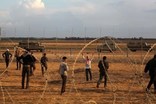
2 Palestinians were injured after the explosion of an Israeli military ordnance
The Israeli Occupation Forces (IOF) arrested Sunday evening three Palestinians for crossing the border fence east of the Gaza Strip.
Palestinian sources said that three unarmed young men were detained while trying to cross the border fence.
The three detainees were taken for investigation, the sources added.
Since November 2014, more than 80 Gazans were detained for crossing the border fence in an attempt to reach the 1948 occupied territories looking for job opportunities due to the very difficult living and economic conditions in the besieged Strip.
Meanwhile, two Palestinians were injured after the explosion of an Israeli military ordnance in the Gaza Strip on Sunday.
Medics said that two citizens suffered moderate injuries after an ordnance exploded in Shujaia neighborhood east of Gaza City.
The injured were taken to Shifa Hospital in Gaza City for treatment, the sources added.
Several Palestinians either died or were wounded due to the explosion of Israeli military ordnance left over during Israeli offensives on the Gaza Strip.
The Israeli Occupation Forces (IOF) arrested Sunday evening three Palestinians for crossing the border fence east of the Gaza Strip.
Palestinian sources said that three unarmed young men were detained while trying to cross the border fence.
The three detainees were taken for investigation, the sources added.
Since November 2014, more than 80 Gazans were detained for crossing the border fence in an attempt to reach the 1948 occupied territories looking for job opportunities due to the very difficult living and economic conditions in the besieged Strip.
Meanwhile, two Palestinians were injured after the explosion of an Israeli military ordnance in the Gaza Strip on Sunday.
Medics said that two citizens suffered moderate injuries after an ordnance exploded in Shujaia neighborhood east of Gaza City.
The injured were taken to Shifa Hospital in Gaza City for treatment, the sources added.
Several Palestinians either died or were wounded due to the explosion of Israeli military ordnance left over during Israeli offensives on the Gaza Strip.
5 apr 2015
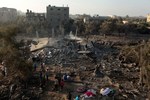
The Italian government pledged to provide long-term loans to Gaza as part of its intents to boost economic enterprises in the blockaded enclave.
The pledges were made during a meeting held in Gaza on Saturday between Palestinian businessmen and a senior Italian delegation to discuss possible ways to enter the rebuilding materials needed to initiate vital economic projects.
The Italian ambassador, who was a member of the visiting delegation, presented bids offering long-term loans of up to seven years and with sums ranging from 50,000 to 500,000 Euros.
The Italian government would also guarantee the entry of the needed machinery and raw materials from Italy to Gaza, in coordination with the Israeli occupation authorities.
For his part, head of the Palestinian Businessmen Association, Ali al-Hayek, called for backing up the private sector in Gaza and urging the IOA to lift the siege and unblock the border-crossings so as to boost the reconstruction process.
Al-Hayek further called on the Italian ambassador to foster bilateral commercial exchange between Italy and Palestine and to allow Palestinian businessmen easy access into Rome.
He also pushed for dispatching Italian engineers to Gaza so as to train Palestinian technical and professional personnel as a means to catch up on the damages inflicted by the latest Israeli offensive on the besieged coastal enclave.
The pledges were made during a meeting held in Gaza on Saturday between Palestinian businessmen and a senior Italian delegation to discuss possible ways to enter the rebuilding materials needed to initiate vital economic projects.
The Italian ambassador, who was a member of the visiting delegation, presented bids offering long-term loans of up to seven years and with sums ranging from 50,000 to 500,000 Euros.
The Italian government would also guarantee the entry of the needed machinery and raw materials from Italy to Gaza, in coordination with the Israeli occupation authorities.
For his part, head of the Palestinian Businessmen Association, Ali al-Hayek, called for backing up the private sector in Gaza and urging the IOA to lift the siege and unblock the border-crossings so as to boost the reconstruction process.
Al-Hayek further called on the Italian ambassador to foster bilateral commercial exchange between Italy and Palestine and to allow Palestinian businessmen easy access into Rome.
He also pushed for dispatching Italian engineers to Gaza so as to train Palestinian technical and professional personnel as a means to catch up on the damages inflicted by the latest Israeli offensive on the besieged coastal enclave.
Truce violations List of names Pictures of martyrs
Days: Aug: 26 - 25 - 24 - 23 - 22 - 21 - 20 - 19 - 18 - 17 - 16 - 15 - 14 - 13 - 12 - 11 - 10 - 9 - 8 - 7 - 6 - 5 - 4 - 3 - 2 - 1
July: 31 - 30 - 29 - 28 - 27 - 26 - 25 - 24 - 23 - 22 - 21 - 20 - 19 - 18 - 17 - 16 - 15 - 14 - 13 - 12 - 11 - 10 - 9 - 8
